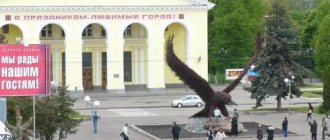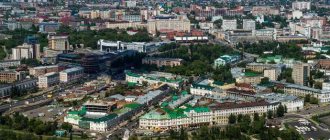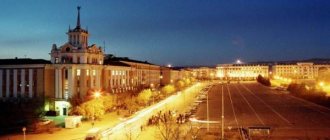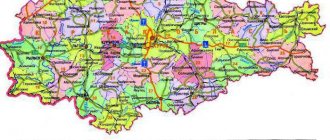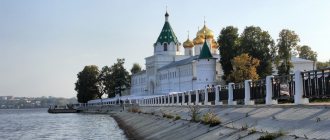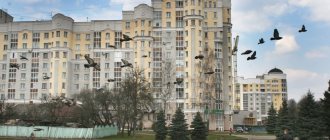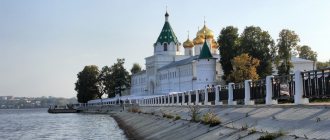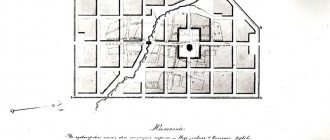Founded: 1566
City Day is celebrated
on August 5th
.
In 2021, due to the pandemic, mass events in honor of the city day are canceled or may be postponed
Historical city center
Eagle
is a Russian city, the center of the Oryol region, located on both sides of the Oka River and its tributary Orlik.
The city was founded in the 12th century, in the 15th century this territory was captured by the Grand Duchy of Lithuania and the inhabitants left the city.
In 1566
Ivan the Terrible's decree revives the fortress and the city. In 1605, Orel was captured by the troops of False Dmitry I. From 1607 to 1608, Orel was the residence of False Dmitry II.
In 1615 the city was destroyed by Polish troops, and only in 1636 it was restored. It was repeatedly attacked by the Crimean Tatars. Since the 17th century, Orel has been the center of grain trade along the Oka River. In the 18th century, the fortress lost its significance and was dismantled. The railway passed through the city in the second half of the 19th century, which stopped shipping on the Oka. Oryol is known for its frontier battles during the Civil War.
During the Great Patriotic War, on October 3, 1941, Orel was captured by Guderian's tank group. During the occupation, there was active underground activity here. The city was liberated during the Oryol strategic operation “Kutuzov” on August 5, 1943. On the same day, in honor of this victory, an artillery salute was given in Moscow - the first during the Great Patriotic War
. And on September 19, 1943, the first parade of partisan formations in the history of the Patriotic War took place in Orel.
For the courage, resilience and mass heroism shown by the city’s defenders in the struggle for freedom and independence of the Fatherland, by Decree of the President of the Russian Federation of April 27, 2007 No. 560, the city of Orel was awarded the honorary title “City of Military Glory.”
Not without the symbol of the city - the proud eagle. Sculpture on the station square The biographies of many cultural figures are closely connected with the history of Orel. The city has museums of I. Turgenev, N. Andreev, N. Leskov, I. Bunin, A. Fet, M. Prishvin. In the post-war period, the city became a famous educational and industrial center.
Oryol is notable for its large number of well-preserved temples and other historical buildings. Orel is also interesting for its secret dungeons. The old part of the city is located on karst faults, and there were also quarries there. During the war, the dungeons were actively used by partisans. Now, although they are fraught with many dangers, they attract adventure lovers.
About 303 thousand people live in Orel (2020).
Citizens celebrate City Day
August 5, it coincides with the Day of Liberation of Orel from the Nazis.
Brief description of the city of Eagle
Orel is a famous Russian city, which is the administrative center of the Oryol region.
The first mention of the city dates back to the 12th century. Oryol is located on the banks of the ancient Russian river Oka, as well as its picturesque tributary, Orlik. It was the rivers that gave the city its name. The city of Orel is administratively divided into 4 districts, each of which has its own name - Severny, Zavodskoy, Sovetsky and Zheleznodorozhny.
Save on your trip to Oryol!
Basic moments
Today Oryol is a major industrial and agricultural center in Russia. The city has machine-building and instrument-making enterprises, and light industry is developed. In addition, the city is both a railway and automobile center of our country.
Tourists should visit Oryol to admire the ancient buildings of the city, primarily the numerous temples and churches. In addition, the city has museums dedicated to the great Russian writers - Turgenev, Andreev, Bunin, Leskov.
There are approximately 17 hotels of various categories in Orel, restaurants and cafes are open, and the tourism infrastructure is developing.
Climate
The climate of Orel belongs to the temperate continental type. Winters here are moderately cool, and summers can be both hot and moderate in temperature.
Attractions
Oryol's attractions include numerous architectural and religious monuments.
Thus, the most interesting sights of Orel for tourists include: a monument to the poet Yesenin, which stands on the site where the house of his wife, Zinaida Reich, used to be located; monument to the heroes of the Civil War; commercial bank building.
The religious attractions of Orel include numerous temples – the Church of the Iveron Mother of God, the Church of the Icon of the Mother of God “The Sign”, the Holy Dormition Monastery and many others.
Orel's attractions, such as museums, are also interesting, in particular, of such Russian writers as Turgenev, Bunin and others.
The natural attractions of Orel include the spit of the Oka and Orlik rivers. You should also visit Tankmen's Square.
Excursions
First of all, we recommend that tourists go on a sightseeing tour of Orel.
Excursions to holy places from Orel are also interesting: a visit to the Life-Giving Cross in the village of Godenovo, a bus tour to Kostomarovo, a visit to Optina Hermitage.
We also recommend such excursions in Oryol as “The Literary Eagle”, “Nature and People of the Oryol Region”, etc.
In the warm season, we recommend excursions along the Oka River by water transport.
Story
The history of Orel began around the 12th century - at that time the first settlements appeared in local territories.
Orel was founded by Ivan the Terrible in 1566. Initially, the history of Orel is the history of a fortress located on the southern outskirts of the Moscow state.
Under Tsar Peter the Great, the city became a province; at the end of the 18th century it had already become a major center of the Oryol province. In addition, Oryol was also the center of the Orthodox Oryol-Sevsk diocese.
In the 17th century, the history of Orlov was for some time associated with False Dmitry the First, and then the Second. Also at this time, the Poles attacked Oryol.
In the same 17th century, churches were actively erected in Orel, and the Vvedensky Monastery was opened. At the end of the 17th century, a sailing factory opened in Orel.
In 1815, the first theater opened in Orel. In 1868, a railway was brought to Orel.
The city was repeatedly visited by such people as Pushkin, Zhukovsky, Leo Tolstoy, Yesenin, Tchaikovsky, Tvardovsky and many others.
After the Great Patriotic War, 167 residents of Orel were awarded the title of Hero of the USSR.
Today Orel is an attractive city for tourists with good infrastructure, which has preserved its ancient appearance.
Accommodation
Orel hotels are a variety of hotels, both designed for budget tourists (Dubrava, Mayak - from 300 rubles per day), and hotels of a higher category (Ackerman, Orel, Sarkis - from 1' 000 rubles per day and above).
Note that hotels in Orel are located both in the city center and on the outskirts of Orel.
Sports and active recreation
Orel offers tourists various sports, in particular, sports you can practice karate, orienteering, aerobics, athletics, judo, boxing, etc. There is also a football club in Orel. In addition, a popular sport in Orel, common in the Netherlands, is korfball.
Transport
Orel is a major transport hub - it is in this city that 7 major highways converge, which are of national importance. Also, railway lines leading to such cities of the Russian Federation as Moscow, Yelets, Kursk, etc. converge here.
Buses, trolleybuses and trams run around the city. Tourists can also travel around Orel by minibuses or taxis.
A river bus runs along the Oka River in Oryol.
Shopping
The main souvenirs of the Eagle are, of course, various images of the Eagle, the symbol of the city. Be sure to purchase an eagle figurine made of glass.
Other Oryol souvenirs are ceramic magnets and bells with views of the city, as well as plates and cups with an Oryol theme.
You can also buy souvenirs in Orel, such as shot glasses and beer glasses with views of Orel.
How to get there
You can get from Moscow to Orel by bus. The travel time will be 6 hours, the fare will be approximately 600 rubles.
You can also get to Orel from Moscow by train from Kursky Station. Travel time is approximately 5 hours, ticket cost is 500-600 rubles.
In addition, you can get to Orel by car along the M2 highway. The distance from Moscow to Orel is 362 km.
History of the coat of arms
Just like the city flag, the coat of arms with the Eagle was not invented in 1998. It appeared much earlier, namely in 1730. At first it was used as a symbol of the Oryol Regiment. Then it was more detailed: the fortress was depicted more artistically and was crowned with red roofs, it stood on green hills, and on top of it sat an eagle with a golden crown on its head.
In 1781, the coat of arms with an eagle was approved as the official city symbol. Its style has changed somewhat, and the roofs on the fortress have become white, but the general appearance remains the same. In the 18th century it changed dramatically. The coat of arms depicted a stone fortress with three towers, above which is a golden imperial eagle with two heads and a crown above them. The heraldic shield was crowned with a gold imperial crown, and on its sides was framed by golden oak leaves intertwined with a blue St. Andrew's ribbon.
The modern appearance of the city symbol is close to the very first version, but its image style has become more schematic, and there is no crown on the bird’s head. The golden double-headed eagle and the fortress with three towers from the 18th century version now adorn the region's coat of arms.
Report on the topic of the city of Orel
The city of Orel was founded as a fortress during the reign of Ivan the Terrible in 1566. The fortress was located along the banks of the Oka River. She was defensive in nature. Later it became the center of Oryol district. But over time, Orel becomes an important trading point.
Orel is located 380 km from Moscow. You can get from Moscow to Orel by train, bus or car. Residents travel around the city by trams, buses, trolleybuses and minibuses.
The city of Orel is surrounded by Bryansk, Tula, Kursk and Kaluga regions.
The city is located in the continental climate zone. Winter is moderately cold. February has the coldest days. Summer is warm. The hottest month is July. There are lakes in the city. In the south of the city there is the largest lake - Bright Life.
Currently, the city is the center of the Oryol region and a large industrial center. There is a steel rolling plant, a hosiery factory, a mechanical engineering plant, as well as factories for the production of ventilation and textile equipment.
The city has a length of more than 100 km, divided into 4 districts: Northern, Zheleznodorozhny, Sovetsky, Zavodskoy. The latter is the oldest district. It was here that the construction of the city began; the Orel fortress was built here. Now the area is surrounded by factories. Sovetsky district is the city center. There are many attractions, shops, squares and green gardens. The railway station building is located in the Railway District. The northern district is the youngest district where modern multi-storey buildings have been built.
The city's population is just over 317,000 people. Not only indigenous people live in the city, there are also Chechens, Ukrainians, and Belarusians
Orel is famous for its large number of higher educational institutions. The State University with a large number of faculties, the Modern Humanitarian Academy and others are open to students.
In 1897, a local history museum was opened in Orel, where you can learn the history of the city and region.
Local residents love to relax in the city park. The park is located on the banks of the Oka River. There is a boat station at this place. In the center of the park they built a beautiful fountain, an amusement area, a shooting range and a rope park.
In addition to the culture and recreation park, Oryol has a park called Botanica. This is a natural forested area within the city. Botany is famous for its nursery, greenhouse, gardening school and fruit and berry station.
List of films, songs, books dedicated to the city
The centuries-old history of the Oryol region and its capital has accumulated a lot of interesting material for creative work. Many songs and books have been written about the city. Oryol has become a film location for several feature films and documentaries. We invite you to familiarize yourself with a short list of works:
- songs: “My Orlovye” (N. Afanasenko), “Old Park” (N. Vasiliev), “Waltz about our city” (E. Derbenko);
- books: “My 1st Kursk” (Alekseeva L.I.), “Oryol Sketches” (V.A. Vlasov), “The Original Eagle” (V. Nedelin);
- films: “On Thin Ice”, “Fathers and Sons”, “Own Opinion”.
It is worth adding that Orel bears the unofficial title of “Capital of Russian Literature.” The city has seen many famous writers on its streets who considered it an honor to dedicate prose or poetry to it.
Video 4. All the sights of the city OREL (2015)
Alexander, June 7, 2021.
Popular message topics
Planting in the country: Used as an unusual, wild plant. In large quantities they create a bluish color. Eryngium takes root well in sandy soil. As seedlings, the plant practically does not take root in place.
From time immemorial, rulers of states have sought to strengthen their dominance, seize lands, and have as much power and values at their disposal as possible. This was the reason for the military campaigns of the pharaohs. However,
Russia is rich in beautiful places, forests and rivers. One of the largest rivers in all of Europe is the Volga. This amazingly beautiful and stormy river originates from the Tver region. It flows through several countries and regions,
About the city of Orel
Orel is a wonderful old town that combines the charm of old architecture and the functionality of modern buildings. It is located on the Central Russian Upland on both sides of the Oka River and its tributary Orlik. The population is about 341 thousand inhabitants. It was founded in 1566 as a fortress to protect the southern borders of the state. Oryol received city status in 1702. Subsequently, the city was administratively part of various provinces of the country, and in 1778 it became the center of the Oryol province.
During its existence, Orel has gone through a development path from a small fortress with adjacent settlements to a modern cultural and industrial center of the region.
In the entire history of Orel, not a single military campaign has passed it by. More than once he stood in the way of his enemies and gave them a crushing rebuff. Orel is a city of military glory of the Russian Federation. For two years during the Great Patriotic War it was under occupation by fascist troops. The city was liberated during the battle on the Oryol-Kursk Bulge. Orel suffered severe damage and its restoration became one of the main post-war construction projects of the USSR. A well-known memorable fact that city residents are proud of was the first artillery salute in the history of the Great Patriotic War in honor of the liberation by Soviet troops from the German fascists. In honor of this, every year on August 5, Oryol celebrates City Day.
Orel was revived quite quickly - within three months after the liberation of the city, 26 enterprises were revived. New industries have emerged: municipal road and mechanical engineering, production of tractor spare parts and building materials, as well as instrument making. Housing, schools, hospitals, kindergartens, universities, and cultural institutions were built. Thirty monuments and commemorative steles, as well as twenty sculptural busts, monumental mosaics, bas-reliefs and paintings were built in the squares, streets and gardens of the city. The number of memorial plaques in Orel has already reached seventy, and there are several hundred gravestone monuments, many of which are genuine works of art. The fertile lands located around Orel have always attracted the most prominent noble families to the city, thanks to which it has become the center of noble culture.
Orel is the birthplace of writers I.S. Turgenev and L.N. Andreev, historian T.N. Granovsky, philosopher M.M. Bakhtin. The life and work of I.A. Bunin, N.S. Leskov, A.N. Apukhtin and many other outstanding people are connected with the city of Orel. Among the city's Honorary Citizens are Marshal Kulikov and Hero of the Soviet Union, pilot Alexei Maresyev, who continued to fight with amputated legs.
Modern Orel is a scientific and industrial center, a leading link in the socio-political and cultural life of the Black Earth Region. The city is a large industrial center of one of the most important agricultural regions of the country. Instrument making and mechanical engineering are most developed there, and there are enterprises in the steel rolling, light and food industries.
The city has a well-developed trading infrastructure.
Oryol is a student city; there are 12 higher educational institutions with about 50 thousand students.
In recent years, Oryol has become noticeably younger. Orel's neighborhoods are built according to individual projects, so that the architecture itself creates the mood. The city is being built, growing upward, decorated with squares, parks and fountains. He carefully preserves the traditions of Russian spirituality. One after another, the temples and cathedrals of Orel are being restored and restored.
Oryol is a major road and rail transport hub. Orel's intracity transport infrastructure consists of: tram tracks, trolleybus lines, bus routes, urban and suburban transport.
Due to the fact that the traffic of polluting vehicles in Orel is not intense and the city is surrounded by greenery, the city air remains unpolluted and healthy. This undoubtedly attracts tourists there. Orel, located in the heart of central Russia, is a wonderful city that is worthy of a visit. It is known for its rich historical past and literary traditions.
In Orel there is a large number of entertainments for all ages, from young to old. The main tourist attractions of Orel are Vasilievskaya, Iverskaya, Krestitelskaya, Mikhailo-Arkhangelskaya, Nikolo-Peskovskaya, Smolenskaya and Trinity churches, two active monasteries, monuments to Russian writers N.S. Leskov, I.S. Turgenev and I.A. Bunin. The city has 4 theatres, a philharmonic society, 11 museums, 4 cinemas, several parks and others.
Near various attractions there are hotels whose doors are warmly open to city guests.
Features of the holiday
Festive events take place throughout the pre-holiday week. One of the main events is dedicated to the day of the liberation of the city. In the first days of August, representatives of the mayor's office visit the veteran liberators. As of 2021, there are 21 people left. The elderly are shown respect through a solemn speech and are given memorable gifts.
Remembrance rallies are being held in some areas of the city. According to tradition, event participants lay flowers at the monuments: Komsomol Heroes L.N. Gurtiev, I.V. Voronov and at the stele “Eagle - City of Military Glory”.
Video 2. Airborne Forces. Orel City Day August 5, 2015
On City Day, August 5, a massive gathering of citizens takes place at Peace Square, where they are congratulated by the top officials of the Administration. Then, exactly at 10:00, 2 flags are solemnly raised: City and Red Army. After the official ceremony, a youth action begins at the intersection of the lane. Georgievsky and st. Lenin. In 2021 it was called “The War I Survived.”
At the Military History Museum, passports are solemnly presented to young people over 14 years of age. From 12:00 in all areas of the city there are concerts, festivals, receptions, exhibitions, sports and festive events. At 16:00 on Lenin Square, a company of honor guard demonstrates its trained skills.
By 21:00, townspeople flock to Lenin Square, where Russian pop stars perform for them. In 2018, the group “Lube” performed their songs. At 22:00 volleys of festive fireworks were heard, and then the concert was continued by the rock band “Black Coffee”.
In addition: Find out what date the Honey Savior is celebrated in August.
Video 3. Brief video essay about the celebrations of August 5, 2018
Location of Oryol
It is located on the Central Russian Hill, which is located in the European part of Russia. In order to understand where the city of Orel is located on the map, you need to look south from the capital (Moscow), the distance is approximately 380 km. It is more than 1000 km away from St. Petersburg. Near the Oryol region there are Kaluga, Tula, Kursk, Bryansk and Lipetsk. They have common boundaries.
Orel is a city that is the center of the region. Its length from south to north is about 150 km, and its width (west-east) is more than 200 km. The Oryol region is the smallest in Russia. It also has the smallest population.
New symbol
In 2002, an updated flag and coat of arms of the city of Oryol was developed and approved.
The new version of the heraldic shield depicts a silver fortress with three towers and gates in the middle part, but the eagle has become golden and double-headed with three crowns. The upper part of the coat of arms is azure, the lower part is green. At the foot of the fortress lies an open book, framed on both sides by ears of corn. The development of this symbol was carried out by artists Vladimir Blinov and Givi Kolmakhelidze. Some people like the new sign for the region and its center, while others think that the old one was better. Be that as it may, the emblem remains symbolic and understandable to everyone. It is unlikely that anyone will have the following question: “Which city’s coat of arms is an eagle on a fortress in a field?” The proud bird remains the symbol and guardian of the region. And this is the most important thing.
Population
Oryol, whose population is decreasing every year, is considered an original Russian city. The indigenous inhabitants, of course, are Russians. In percentage terms, they are about 95%. However, other nationalities also live in the territory, although there are fewer of them - 5%. There are less than 2% of Ukrainians in Orel, 1% of Chechens, Azerbaijanis, Belarusians and Armenians, and 2% of other nationalities.
By the beginning of 2000, the population was about 330 thousand people. However, by 2014 this figure had decreased by approximately 13,000 (317 thousand).
Utility costs
From July 1, 2021, the cost of utilities in Orel has increased. Now prices for housing and communal services look like this:
- Electricity supply - 3.62 rubles/kWh.
- Water supply - 15.81 rubles/m³.
- Water disposal - 13.19 rubles/m³.
- Heating - 1804.18 rubles/Gcal.
- Hot water - 118.47 rubles/m³.
On average, Oryol residents pay up to 4,000 rubles/month for housing and communal services. The final amount is influenced by factors such as the area of the apartment and electrical energy consumption.
Recently, a housing and communal services reform was carried out, which caused discontent among city residents. Now part of the common house debt is added to the monthly amount.
If the house is inhabited by persistent defaulters who are in debt to the state, then the corresponding amount is distributed among the neighbors.
Cultural heritage
“City on the Oka” - this is how those who consider themselves a native resident of such a beautiful city as Oryol affectionately call their native land. The population here honors its history and constantly supports the cultural development of the regional center. Residents respect the works of Russian writers such as Turgenev, Bunin, Fet, Andreev, Rusanov, Granovskaya. After all, these names are known to everyone. In Orel there is a famous cultural monument - the Nobles' Nest (Turgenev's estate). The largest source of the Volga, the Oka River, originates here. The city is also famous for the fact that in 1943, on August 5, the first fireworks went off in Orel and Belgorod in honor of liberation from German occupation. This testifies to the courageous character of the residents.
Orel is considered a “green” city. Both in the very center and beyond, the level of vegetation exceeds 7% of the occupied area.
Granovsky House-Museum
The museum is housed in a wooden house. From the outside it looks simple, but inside there are exhibits that will be of interest to tourists. The exhibition tells about the activities of the Russian philosopher and historian Timofey Granovsky.
The rooms of the house display things and documents of the historian, as well as objects of applied art (such as pottery, lace). As in the local history museum, interesting master classes on folk art are often held here.
house-museum of the writer Leskov is located very close by . From the outside it is a beautiful building in the old Russian style, which wonderfully reflects the spirit of its time.
Granovsky House-Museum
City of Orel today
In 2021, Orel celebrates a major date - 450 years since its founding. Currently, the city has turned into a developed regional center, providing employment to more than 80% of the region's population. The main field of activity is trade. The largest supermarket chains in Russia successfully operate in this area. The industry is gradually declining. But previously it was thanks to her that the city of Orel was promising. The population, according to the 2012 census, was more than 318 thousand people, which, compared to previous years, shows a decrease in growth dynamics.
New symbol
In 2002, an updated flag and coat of arms of the city of Oryol was developed and approved.
The new version of the heraldic shield depicts a silver fortress with three towers and gates in the middle part, but the eagle has become golden and double-headed with three crowns. The upper part of the coat of arms is azure, the lower part is green. At the foot of the fortress lies an open book, framed on both sides by ears of corn. The development of this symbol was carried out by artists Vladimir Blinov and Givi Kolmakhelidze. Some people like the new sign for the region and its center, while others think that the old one was better. Be that as it may, the emblem remains symbolic and understandable to everyone. It is unlikely that anyone will have the following question: “Which city’s coat of arms is an eagle on a fortress in a field?” The proud bird remains the symbol and guardian of the region. And this is the most important thing.
Monuments
A distinctive feature of the city is its literary heritage (it is the birthplace of the famous writers mentioned above) and architectural monuments. In the very heart of the city - on Karl Marx Square - a mighty horseman rises. This is General Alexey Ermolov. The sculpture was erected in 2012. In the Northern District there is a monument to Alyosha the steelmaker. In the shopping part of the city, opposite the central department store, there is Tankmen's Square, which is guarded by a guard of honor. In memory of the fallen soldiers, an eternal flame burns.
Turgenev Museum
On the first day of their stay in Orel, travelers have time to visit the historical “heart” of the city - the Epiphany Cathedral and Memorial Square . And it makes sense to devote the second day to studying museum exhibitions in order to better understand Russian culture and history of the 19th century.
The Turgenev Museum is one of the oldest museum complexes in Russia . This is a place where everything is permeated with the spirit of literature and history. The intimacy of the halls, the interior of the premises, and the items on display create an incredible atmosphere of immersion in the era of the 19th century.
The exhibitions here are treated with care, and excursions are accompanied by fascinating stories from the writer’s life. The staff will do everything to make visitors mentally transported to Turgenev’s era and fall in love with the writer’s work. The galleries also often host exhibitions of foreign art-related exhibits.
Turgenev Museum
Districts of Orel
The city's territory is divided into 4 districts: Zheleznodorozhny, Zavodskoy, Severny and Sovetsky.
- Sovetsky district is the central part of the city. On its territory you can see attractions, heritage, public gardens, streets, shops and squares. Entertainment events, fairs, and youth competitions are held here. This area is considered privileged; about 81 thousand people live here.
- The Zavodskoy district is a vast territory with a high population density (more than 107 thousand people). The industrial core of the city is located here: factories, workshops, factories.
- The northern region is considered the youngest. It has many not only factories, but also budgetary institutions. It ranks third in terms of the number of inhabitants; about 68 thousand people live here.
- The railway district of the city of Oryol is famous for its main attraction - the station. The symbol of the city - a huge eagle with its wings spread - greets residents and guests opposite the main entrance. The population in this area is about 63 thousand people.
Where to stay in Oryol
For a traveler seeking to better understand the historical places of Orel, the city offers accommodation in hotels, apartments, and hostels. If we take into account the central part of the city, lying on both sides of the Oka and full of attractions, hotels are rare and most do not have a specific category. There are a few more on the outskirts. Among them, the Grinn Hotel and Spa, located at the southern entrance along the Kromskoye Highway, stands out brightly - a large hotel in the shopping center of the same name and a park version in the ancient Russian style, Znamenskaya Bogatyrskaya Outpost. Apartments allow you to significantly expand your search options closer to the center, choosing, for example, apartments overlooking the Oka embankment.
- Oryol Hotels
- Hostels for Budget Travelers
- Flats and apartments
Bonus when booking accommodation with Booking.com and Tourist. Ru - cashback for your profitable trip. Cashback promotion for Tourist. RU
Museum of Fine Arts Photo: © Anna Kudryavtseva
Enterprises and educational institutions
Oryol is often called the “city of students.” The population, especially young people, can freely receive a prestigious education. Here, for every seventh resident there is one student. There are many government and commercial educational institutions in the regional center. The most famous of them: OSU named after I. S. Turgenev, OSAU, PSU, OGIET, Financial University under the Government of the Russian Federation and others.
The largest enterprises in the city are OJSC Orelstroy, CJSC Dormash, JSC Proton, NPJSC Nauchpribor, OJSC Severstalmetiz, LLC Plant named after. Medvedev" and others.
Stories, routes and tourist tips
If you are going to Oryol, we recommend that you read the real reviews of tourists who visited the city. Perhaps their experience will be useful to you.
Take a look at the tourist materials:
- Impressions of Andrey and Valeria’s trip “Eagle in the year of the 200th anniversary of I. S. Turgenev”
- Photo album of Lyudmila “City under the wing of an eagle”
- Anna's stories "Eagle - the city of military glory", "Literary Eagle"
We also remind you that the site has a “Questions and Answers” , where, if necessary, you can not only check with experts for up-to-date information about specific city attractions, but also seek advice on issues that interest you regarding your planned trip to Oryol.
All tourist reviews about the trip to Orel on Tourister. RU
Famous places in the city
Recreation places where locals and guests spend time are the City Park of Culture and Recreation, Lake Bright Life, and Alexander Bridge.
The multifunctional complex, which includes many shops, cafes, restaurants, and entertainment centers, has gained the greatest popularity among young people. Here are the largest nightclub in the Black Earth Region “Clocks”, karaoke bar “Night”, “Celebration Restaurant” and others. Other famous establishments in the city include the Labyrinth restaurant, the karaoke club Oz-bar, and the Na Privale cafe.
Flag
The Eagle flag is made in the form of a rectangular panel. The ratio of its sides is 3:5. It consists of two vertical stripes: on the left - blue, on the right - red, in a ratio of 1:9. In the center of the latter there is an image of the city's coat of arms. Its width occupies 1/3 of the part, its height - 3/5 of the same dimensions of the red section. In its upper left corner there is a golden crossed hammer and sickle and a star.
The artistic composition was accepted on January 29, 1998.
